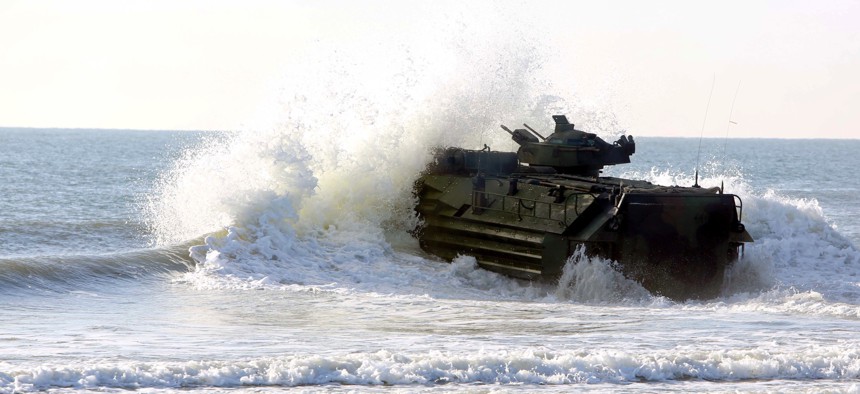
An Assault Amphibious Vehicle operates at Camp Lejeune, N.C., in 2017. Marine Corps Sgt. Clemente Garcia
More Actions Expected After 2nd Investigation Into Deadly AAV Sinking
“I have what I need,” the Marine Corps commandant said Wednesday.
After a second Marine Corps investigation into command leadership in the wake of last year’s deadly amphibious assault vehicle accident, Commandant Gen. David Berger says he’s ready to talk to Acting Navy Secretary Thomas Harker about what actions and accountability to take.
“I have a very clear picture right now, all the way up the chain. And so I don't need any more...to have a discussion with the secretary. I have what I need right now,” Berger said during a discussion with reporters Wednesday.
Eight Marines and a sailor were killed in July 2020 when their amphibious assault vehicle sank during a pre-deployment training exercise off the California coast. Berger said the sinking of the AAV and the deaths were preventable.
A Marine Corps command investigation into the incident released in March found failures with training, maintenance, and adherence to policies and procedures. The services then launched a second investigation into what issues and failures led up to the sinking, looking into several levels of command involved, including 15th Marine Expeditionary Unit, 1st Marine Division, and I Marine Expeditionary Force. This second investigation finished about two weeks ago, Berger said.
The command investigation found that Maj. Gen. Robert Castellvi, who was commander of 1st Marine Division at the time of the accident and later became the Marine Corps Inspector General, bore some responsibility for overseeing the division’s readiness before the Marines involved joined the 15th MEU, but he was not disciplined. Later, on May 3, Berger suspended Castellvi from his position as the inspector general, pending the outcome of the second investigation.
Berger said he did not take action against Castellvi earlier, based on the findings of the command investigation, because he did not see a legal way to do so. However, he still had questions about the formation of 15th MEU and what led to the incident, hence the second investigation.
“We will never hesitate—legal or on the other side—to relieve a commander if we've lost trust and confidence. But I needed to understand in greater depth about how that MEU was composited, which I now know,” he said.
The Marine investigations are just two of five investigations that have examined or are currently looking into the circumstances related to the AAV accident. A Navy safety investigation was conducted concurrent to the command investigation, but its details have not been released. Third Fleet Commander Vice Adm. Scott Conn launched another Navy investigation into the training accident and the service’s role, USNI News reported.
Additionally, a “blue ribbon” panel is being organized to broadly examine amphibious operations for the Navy and Marine Corps. It will consist of experts with backgrounds from the Navy, Marine Corps, and also outside of the Defense Department, Berger said. That panel is expected to take several months to examine where the naval services are with such operations and what they need to do to get to where they need to be in the future, he said.
Despite the tragedy and the age of the amphibious vehicles, Berger said the Marine Corps intends to keep the AAVs until they can be replaced with the new Amphibious Combat Vehicle. Until then, the Marine Corps plans to ensure the AAVs are maintained and inspected properly, he said.
Berger said he is concerned about “our aggressiveness; in our can-do attitude” in overcoming obstacles, and whether people are following the right procedures and ensuring that Marines are meeting the training requirements necessary to conduct operations.
“This is the ultimate test of leadership, right? Balancing your priorities, understanding where you're taking risks,” he said.
One of his priorities is getting the Marine Corps to adjust its approach to safety within training and how they look at and understand those risks.
“I think here we've made some—there's been some positive steps in the last couple of years in how we manage training... But we have—clearly we have to improve the way we look, we make better risk decisions in training,” he said.
While he can’t promise that a similar incident won’t happen again due to the high-risk nature of the training, Berger said he promises to do everything possible to prevent it.
“The final accountability rests with me, with one person. And we have to do what we need to do to fix what needs to be fixed. That responsibility rests with me,” he said.




